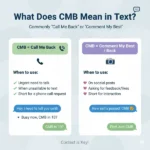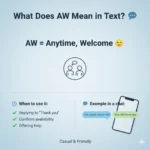ok meaning in text — the first time I saw it in a chat, I honestly paused. I thought, “Why just ok? Are they upset? Busy? Bored?” The tiny two-letter reply felt strangely powerful. And if you’re reading this, chances are you’ve also received an “ok” that left you wondering what the sender really meant. ok meaning in text can feel friendly in one moment and cold in another. ok meaning in text shifts depending on tone, punctuation, and context — which is why it confuses so many people.
Quick Answer: OK means “all right” or “yes.” It’s a neutral, casual, and widely used way to confirm, agree, or acknowledge something in text.
🧠 What Does OK Mean in Text?
In texting, OK simply means “all right,” “yes,” or “got it.”
It’s used to show agreement, acceptance, or acknowledgment.
Example:
A: “I’ll be there by 7.”
B: “ok 👍”
It’s short, simple, and usually neutral — not overly emotional unless paired with punctuation or emojis.
In short: OK = all right / yes = a quick acknowledgment.
📱 Where Is OK Commonly Used?
You’ll find ok everywhere because it’s one of the most universal responses online:
- 📱 Text messages
- 💬 WhatsApp chats
- 🧊 Snapchat responses
- 📸 Instagram DMs
- 🎮 Gaming chats
- 🧵 TikTok comments
- 💻 Work chats like Slack & Teams
Tone:
- Casual
- Neutral
- Can be friendly or cold depending on context
- Not ideal for formal or professional emails
💬 Examples of OK in Conversation
Here are realistic chat-style examples:
1
A: “I’ll send you the files tonight.”
B: “ok cool”
2
A: “Can we talk later?”
B: “ok 👍”
3
A: “I’ll pick you up at 6.”
B: “ok”
4
A: “Don’t forget the charger.”
B: “okkk 😅”
5
A: “I’m running late.”
B: “ok no problem!”
6
A: “Let’s watch a movie?”
B: “ok sure 😄”
7
A: “Meeting moved to 3 pm.”
B: “ok noted.”
🕓 When to Use and When Not to Use OK
✅ When to Use “OK”
- When you’re confirming plans
- When you want a quick reply
- When chatting with friends
- When acknowledging information
- When you want a neutral, simple response
❌ When Not to Use “OK”
- Serious conversations
- Professional emails
- When someone expects enthusiasm
- When responding to emotional messages
- When “OK” might seem cold or dismissive
Comparison Table
| Context | Example Phrase | Why It Works |
|---|---|---|
| Friend Chat | “No worries, ok 😄” | Light, casual, friendly. |
| Work Chat | “Okay, I’ll update it.” | Clear and polite. |
| “Please review and confirm.” (avoid OK) | Sounds more professional and complete. | |
| Serious Talk | “I understand.” | More supportive than “ok.” |
🔄 Similar Slang Words or Alternatives
| Slang | Meaning | When to Use |
|---|---|---|
| K | Short for OK | Super casual, quick texting. |
| kk | “Okay, got it” | Friendly and lighter in tone. |
| Sure | Agreement | Polite, warm confirmation. |
| Gotcha | Understood | When you want informal acknowledgment. |
| Alright | Accepted / agreed | Slightly more formal than OK. |
| Yup | Yes | Casual, positive agreement. |
❓ FAQs About OK
1. Does “ok” mean someone is upset?
Not always. Tone depends on punctuation and context. A plain “ok.” with a period may feel cold. A simple “ok” is usually neutral.
2. What’s the difference between OK and OKAY?
“Okay” feels slightly warmer and more expressive. “OK” is faster and more neutral.
3. Is “ok” rude?
It can seem short or blunt, but it’s not rude by default.
4. Is “kk” better than “ok”?
“kk” feels more friendly because it’s softer. “ok” is more straightforward.
5. Is OK formal?
No. Avoid using “ok” in professional emails or official writing.
Conclusion
OK is one of the simplest and most universal replies in texting. It usually means all right, yes, or I understand — but the tone can shift depending on punctuation, context, or the relationship between the people texting. Whether you’re confirming plans, acknowledging information, or responding casually, “ok” gets the job done quickly and clearly. Use it for everyday chats, but switch to fuller and more polite phrases in formal or emotional situations.
I’ve always believed in the quiet magic of wishes — the kind whispered before blowing out candles or written in the corners of journals. Growing up, I found comfort in words and wonder in small rituals of hope. That love for meaningful expression led me to write and share messages that help others celebrate, heal, and dream. When I’m not crafting wishes, I’m sipping tea by a sunny window or finding beauty in the little things life offers.






